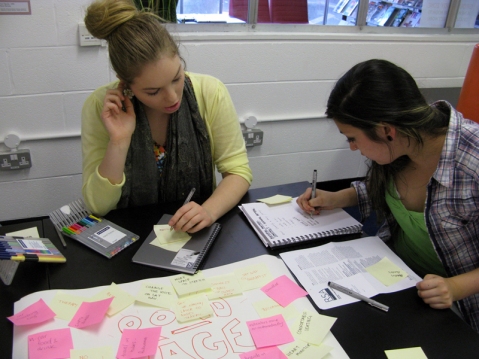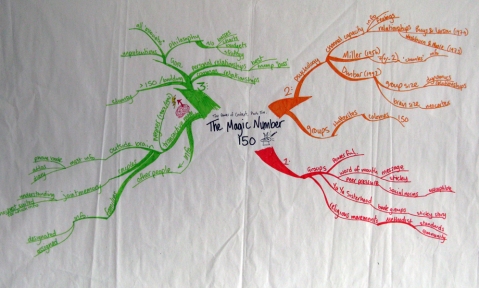Assignment 2, part 1.
Last Friday as part of Change by Design we were split into teams of around five people and introduced to the concept of brainstorming as a way to come up with ideas, names, solutions, designs, anything. We were encouraged to brainstorm in two different ways – either by every team member writing ideas on Post-Its and shouting out their ideas, or by having one team member nominated as a scribe to write down all the ideas of the other team members. I think I preferred the Post-It method – everybody is allowed the same level of input, and hearing other peoples’ ideas shouted out often inspires new ideas to pop into your head.
Today I met with my team to work on the 2nd Change by Design assignment. For this assignment, each team was given a brief at random from the RSA’s Student Design Awards. We got brief 8 – The Good Journey (PDF). “Make people look forward to their daily commute.” is the theme to work to.
We did a bit of brainstorming about what makes peoples’ daily commutes so stressful, and among such suggestions as uneven pavements, pavement hoggers, and drivers who don’t indicate, we settled on looking at road rage in more detail. I don’t think people would mind quite so much the daily car journeys if only there were ways to instantly relieve your stress or anger whilst you were still experiencing it.
We then brainstormed to try to find the reasons why people get road rage, and to find solutions for it, coming up with things like in-car punching bags, squeezy stress balls installed in every car, and just having a chauffeur so that you don’t have to do any of the driving yourself. I, personally, like my suggestion of inventing mass transit tubes like in Futurama! We plan to meet up again soon to complete the assignment, discuss in more detail our ideas (I hope to come up with more – maybe over the next few days when I’m in the car I’ll think of something, because I get road rage even as a passenger!), and settle on one final solution to the ubiquitous road rage problem.
Although I was a bit dubious about being placed in a team with people I don’t know, I realise now that it can actually be very beneficial. It’s very refreshing to speak to people from different disciplines, who are interested in completely different subjects to me, and who will probably take away from this exercise some vastly different opinions and ideas to the ones I do.
Mixing dye paste.
After a print workshop with our technician Norrie this morning where we learned about making printing screens by masking and stencilling (which is exciting in and of itself!), one of the pieces of homework we were given (is it still homework if you can’t take it home to do?) was to mix up a dye paste on our own, without being supervised. We were shown last week how to mix up a dye bath, and the procedure for mixing a print paste is essentially the same, just with a couple of different ingredients. Vanessa and I paired up to do this this afternoon, after our D’Arcy Thompson museum tour fell through, so that we could just get the task out of the way, really – we didn’t really see the point in leaving it for days, when the idea was fresh in our minds and we were already in ‘self-directed study’ time. Also, I trusted Vanessa to keep me right, which she did! In the dye lab I was very overwhelmed to start with – I got a bit confused about what we were doing, I think because I was forgetting that the dyes we mixed last time were something completely different to what we were meant to be doing this time. After spending a few minutes looking over the very helpful (if mildly confusing when you don’t know where to look) work sheets on the wall, we asked Norrie for a little bit of help, and he very nicely reassured us that we were looking in the right place, and things would probably go perfectly well if we just followed the instructions. And they did! Or maybe I should wait until we try printing with the stuff before I congratulate myself…
First, we measured our dye. Norrie is very sneaky, and asked us to mix 400g instead of 100g (the default on the ingredients lists), which meant we had to do some sums. Nothing difficult, thankfully! Looking for a little danger, we chose a mix with three dyes instead of just two, although we stuck with a 3% strength (3% makes the full shade, so no matter how much more dye you add, the colour won’t get any stronger) to save from having to do more sums!
We added some urea (yes, it is what you think it is), ammonium sulphate, Glyezin BC, boiling water, and indalca, which all sound very scientific, but essentially what these things do is help the dye powder to dissolve, or help carry the pigment, or help thicken the mixture, or possibly a bit of all three (I’m not quite up on all the details yet!).
In the end, we produced a nice wee tub of a kind of foresty-greeny sort of dye. Hopefully that’s the colour that’s supposed to appear from this mixture! I can’t wait to print with it and see how it all turns out.
Assignment 1: Mapping Meaning
As part of my Change by Design module, I have read The Tipping Point by Malcolm Gladwell, a book that looks at epidemics of social behavior. I’ve always been a bit of a reader. I absorbed books as a child, and amassed a gigantic collection of Point Horror novels! Although I mainly stick to fiction (Harry Potter, the Sookie Stackhouse novels – my tastes haven’t really changed since I was about twelve, to be honest, but I have done most of the classics and must-reads too!) I rather enjoyed The Tipping Point. I did find the book to be a bit repetitive, but I suppose that’s part of what it takes to make information “sticky”! To complete Assignment 1 of Change by Design I produced an overview of the book as a mind map, and then chose one chapter to look at more closely. It might take another read for me to really get my head around the whole book, because I found that when mind mapping I got a bit mixed up with which chapter was which, and what information came from where.
The chapter I chose to look at in more depth was The Power of Context (Part Two), which is concerned with “the magic number one hundred and fifty”. After a bit of Googling for past students’ blogs I think this might be a bit of an unpopular choice! I chose this chapter because I am quite interested in psychology, and I found the concept that we have a finite capacity for close relationships quite fascinating! I’d never really thought about it before. I was already familiar with Miller’s The Magical Number Seven, but had only ever thought about it in the context of “chunks of information”, sequences of numbers or letters, etc. Dunbar argues that humans evolved bigger brains (with bigger neocortices) in order to better deal with larger social groups. I had never really thought about the brain power associated with having friends before, but it really can be an exhausting exercise – if I think of my closest friends, I can name their partners, many of their family members, a number of their other friends from work or college or university, and who of all of these people is having drama with whom!
I became really interested in the idea of “transactive memory”, where a lot of our information isn’t actually stored in our brains, but elsewhere. If, for example, you had to name the capital city of Bhutan, you probably don’t have that particular piece of information memorised, but you do know that if you look in an atlas (or in one of those fancy notebooks with a list of countries and capitals and a conversion chart on the inside cover, or on the internet) you’ll easily find it. I especially liked the part of the chapter that talks about how couples and families store their information with each other – I go to my boyfriend if I need computer help, for example, or if I need to find out where someplace is, because he’s good at that. I tend to be the one to remember if we have to be somewhere, or things like important dates. That all sounds a bit stereotypical, I think, but there we go!
As part of this assignment, I have also produced an annotated bibliography of my chosen chapter in the Harvard referencing style:
Miller, G. A., 1956. The Magical Number Seven. Psychological Review, 63 (2), pp. 81-97.
Here Miller says that the human mind’s working (or short-term) memory has a capacity of about seven (plus or minus two) pieces of information. Gladwell references Miller to illustrate the channel capacity concept, that humans can only handle taking in and differentiating between so many snippets of information at once.
Buys, C. J. & Larson, K. L., 1979. Human Sympathy Groups. Psychology Reports, 45 (2), pp. 547-553.
Washburn, S. L. & Moore, R., 1973. Ape into Man. Boston: Little, Brown.
These two references talk about human capacity for relationships and group size. People generally only hold about 12 to 15 people close to heart; caring deeply about people can be exhausting and requires a lot of time investment.
Dunbar, R. I. M., 1992. Neocortex Size as a Constraint on Group Size in Primates. Journal of Human Evolution, 20, pp. 469-493.
Dunbar, R. I. M., 1996. Grooming, Gossip, and the Evolution of Language. Cambridge: Harvard University Press.
Dunbar argues that in primates (monkeys, chimps, baboons, humans) group size, the capacity for close relationships, is directly related to the size of the neocortex area of the brain. He has studied many hunter-gatherer tribes for which there is documented history, and found that their group sizes tend to average just below the magic number of one hundred and fifty.
Wegner, D., 1987. Transactive Memory: A Contemporary Analysis of the Group Mind. In: Mullen, B. & Goethals, G. eds.Theories of Group Behavior. New York: Springer-Verlag, pp. 200-201.
Wegner, D., 1991. Transactive Memory in Close Relationships. Journal of Personality and Social Psychology, 61 (6), pp. 923-929.
Wegner describes “transactive memory”, where much of what we remember is not stored in our brain, but outside it; our information tends not to be memorised, but stored elsewhere – in phone books, diaries, atlases, or with our partners, children, or siblings. We then simply memorise what kind of information is stored where, so that we can easily access it when needed.












